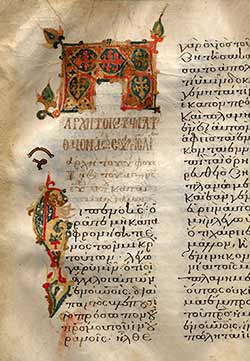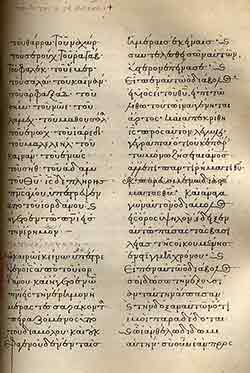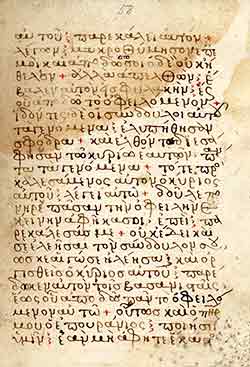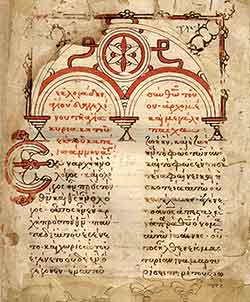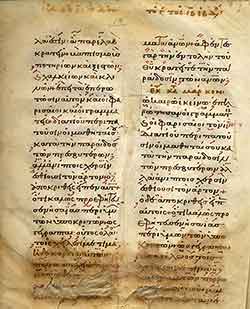The Gruber Rare Books Collection and Other Rare Books
New Testament Lectionaries
All of the following manuscripts were photographed by The Center for the Study of New Testament Manuscripts in 2010. Copies of these photographs are available on a website: http://www.csntm.org/manuscript. Click on "Manuscripts" on the left hand of the screen and look for the appropriate Gregory-Aland number.
Gregory-Aland l 1536. This 14th century daily lectionary of the Gospels is 347 folios long. It has a red-morocco English binding on which is inscribed: Evangelistarium Greek MS on Vellum Sec. XII. The Lord’s Prayer is printed in red and contains the “conclusion” (for thine is the kingdom, etc.) which is not considered original
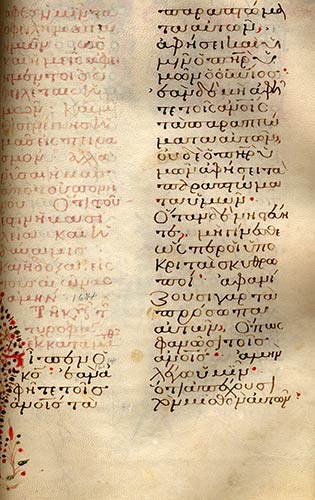
Folio 12, p. 24, has been repaired and the missing text was supplied by Gruber himself on June 12, 1913. Additions in Gruber’s hand also appear in several other parts of the manuscript. The text shown on the left of this page is Matt 18:10-14.
Gregory-Aland l 1624. This 11th century incomplete lectionary of the gospels, daily in John, Saturday and Sunday in Matthew and Luke, is 197 folios long. Folios 142-157 are placed after folios 158-161. The text shown on this page is Luke 15:13-18, folio 197 reverse, from the story of the prodigal son. The manuscript was acquired by Gruber in 1913.
Gruber 56. Gregory-Aland l 1625. Lectionary of the Gospels. 13th-14th centuries
Gregory-Aland l 1625. This 13th-14th century daily lectionary of the Gospels is 250 folios long (12 folios are lacking). The cover has four evangelists in the corners and the crucifixion in the center:
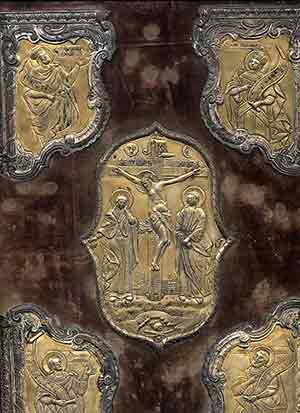
This manuscript was acquired by Gruber in 1913. The text shown on the left is Luke 3:34b-4:7a, folio 82 obverse.. Halfway down the right column, in Luke 4:4, the manuscript reads “but by every word of God,” which is not in the best manuscripts. It also adds at this point “coming out of the mouth of God,” (see Deut 8:3 or Matt 4:4), but a scribe indicates the questionable nature of this reading by adding dots in or around each letter.
Gregory-Aland l 304. This 13th century daily lectionary of the gospels is 219 folios long (many folios are bound out of order). Folio 125 is torn and mostly missing. The text shown here is Matt 18:29-35 from folio 58 obverse.
Gregory-Aland l 1626. This 12th century incomplete lectionary of the gospels is 98 folios long although folios 71-74 are placed after folio 8. It was written by order of Alexis in 1186 C.E. The text shown on the left is Luke 17:3-6 (folio 22 obverse).
Gregory-Aland l 1627. This 12th century lectionary of the gospels is 168 folios long, of which 49 are paper and 119 parchment. The handwriting on the paper pages is different and later than on the parchment. There are four other lectionaries with such a combination of paper and parchment and eleven minuscule manuscripts of the New Testament with mixture of paper and parchment. There are a number of lacunae and some folios are bound out of order. The text shown on the left is John 1:1-7, folio 1 obverse.
See Robert Henry Daube, in Colwell and Riddle: Studies in the Lectionary Text, Vol. I, Prolegomena, 1933, pp. 82, 84-156, for a collation of this manuscript.
Robert Lee Long, The Saints of the Byzantine Lectionaries, Unpublished M. A. thesis at the University of Chicago, 1933.
Gruber 125. Gregory-Aland l 1628. This 11th century fragmentary daily lectionary of the Gospels is 8 folios long. It was acquired by Dr. Gruber in 1920. The text shown on the left is Mark 7:4b-8a, folio 1 obverse.
For more details on these manuscripts see Kenneth W. Clark, A Descriptive Catalogue of Greek New Testament Manuscripts in North America. Chicago: The University of Chicago Press, 1937, pp. 90-106.
The Gruber Collection was assembled by L. Franklin Gruber, President of Chicago Lutheran Theological Seminary, Maywood, Illinois.
Annotation prepared by Ralph W Klein
